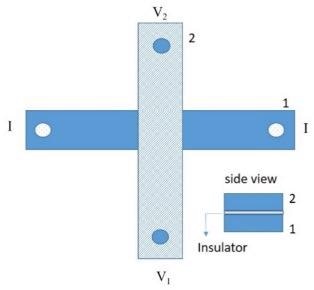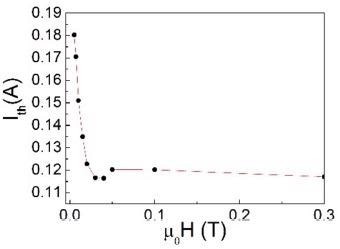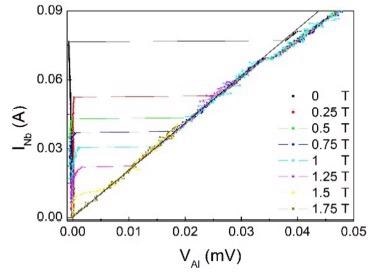A group of researchers from Italy recently studied the unconventional effect of cryogenic temperatures on the electric transport properties by analyzing the effects of drag transverse voltage in a tri-layered system comprising of superconductor-insulator-ferromagnet (S-I-F) in a cross configuration and the presence of a perpendicular magnetic field at a subzero 4.2 Kelvin temperature.

Study: Drag Voltages in a Superconductor/Insulator/Ferromagnet Trilayer. Image Credit: SmartMark/Shutterstock.com
Further, they compared the system with other bilayer systems such as S-F and S-normal metal (N) and found that the insulating barrier plays a major role in determining maximum zero-voltage current and its characteristics. This study is available in the journal Materials.
Multilayered Cryogenic Superconducting Electric Transport Systems
Multilayered cryogenic superconducting systems are layered composites consisting of at least two layers of S and F or S and N, or a third insulating layer (I) sandwiched in between two layers of S and F/N. Below a critical temperature, S experiences superconducting behavior due to the Meissner effect where there is zero electrical resistance and no presence of a magnetic field.
Moreover, in an S-F/N system, when an electric current is driven in one of the layers, charge accumulates in the other layer owing to the Coulomb interaction, which in turn opposes the current flow in the second layer; this is called Coulomb drag. The effect of Coulomb drag in presence of an I layer in between S and F/N layer is an area of focus for many researchers in the field of superconductivity.

Schematic of the transport measurement geometry in cross configuration (planar and side view). I is the bias current and V = V2-V1 is the voltage drop. Image Credit: Romano, P et al., Materials
About the Study
In this study, researchers used niobium (Nb) as S, Al1-xOx as I, Pd0.84Ni0.16 as F, aluminum as N, and obtained S-I-F tri-layer, S-F, and S-N bilayers. All the layers were deposited by a three-source dc magnetron sputtering instrument, equipped with a load-lock chamber, which operated at a base sputtering pressure of 4 x 10-8 mbar and under argon (Ar) environment with a pressure of 3-8 x 10-3. The first layer of 73 nm thick Nb layer was deposited on a 100 µm width silicon (Si) substrate at a rate of 0.3 nm/s.
The second layer of Al1-xOx was deposited on the top of the Nb layer in a cross geometry via two steps. First, a 1.7 nm thick Al layer was deposited at a rate of 0.06 nm/s and exposed to air for 30 minutes to form an oxide layer followed by a second Al layer of 2.8 nm under similar conditions, which put the total thickness of the Al1-xOx layer to 4.5 nm. Finally, the third layer of 50 nm thick Pd0.84Ni0.16 layer was deposited at a rate of 0.2 nm/s on the top of the second layer.
Similarly, Nb-PdNi and Nb-Al bilayers were also synthesized with an analogous procedure to compare with the tri-layer system. Finally, all the samples were electrically characterized by using a four-probe configuration under a perpendicularly applied external magnetic field up to 2 teslas and at a temperature of 4.2 K.

Behavior of Ith at different applied magnetic fields in a. Nb/Al1-xOx/Pd0.84Ni0.16 trilayer, when biasing the sample in the Nb layer (the dashed line is a visual guide). Image Credit: Romano, P et al., Materials
Observations
The current-voltage (I-V) curve, representing current flowing in S and the voltage drop due to Coulomb drag in F, indicated the presence of a non-zero voltage state in the unbiased F layer when the current in the S layer exceeded a certain threshold current (Ith).
Quantitatively, Ith was the value of the current flowing in the S layer that dropped the voltage in the F layer by 0.1 mV. Further, Ith sharply decreased with an increase in the magnetic field up to a value of 400 G, which was close to the coercive field value of Pd0.84Ni0.16; As Ith was much higher than critical current (Ic) for superconductivity of Nb and dependent upon the external magnetic field, it was confirmed that this Ith was not related to Ic. Further, Ith remained constant for a magnetic field above 2 teslas.
On contrary, the maximum zero-voltage indicated by S-F and S-N bilayers is attributed to Ic, which decreased with increasing the magnetic field. Moreover, the S-F bilayer demonstrated a lower transverse-normal-state resistance of 5 x 10-4 Ω than that of the S-N bilayer with 0.45 Ω.

I–V curves at T = 4.2 K at different value of the magnetic fields for a Nb/Al bilayer with current sent in Nb. Image Credit: Romano, P et al., Materials
Conclusions
The researchers fabricated S-I-F tri-layered, S-F, and S-N bi-layered superconducting electric transport systems using Nb, Al1-xOx, Pd0.84Ni0.16, and Al. The presence of an insulation layer in the tri-layer led to the appearance of Ith, which was not related to the Ic of the bi-layered systems, and it was dependent upon the external magnetic field up to the coercive field value of the ferromagnet. The study further suggested investigating the mechanism involving the presence of the insulation layer.
Reference
Romano, P., Polcari, A., Cirillo, C., Attanasio, C., Drag Voltages in a Superconductor/Insulator/Ferromagnet Trilayer. Materials, 2021, 14, 7575. https://www.mdpi.com/1996-1944/14/24/7575
Disclaimer: The views expressed here are those of the author expressed in their private capacity and do not necessarily represent the views of AZoM.com Limited T/A AZoNetwork the owner and operator of this website. This disclaimer forms part of the Terms and conditions of use of this website.